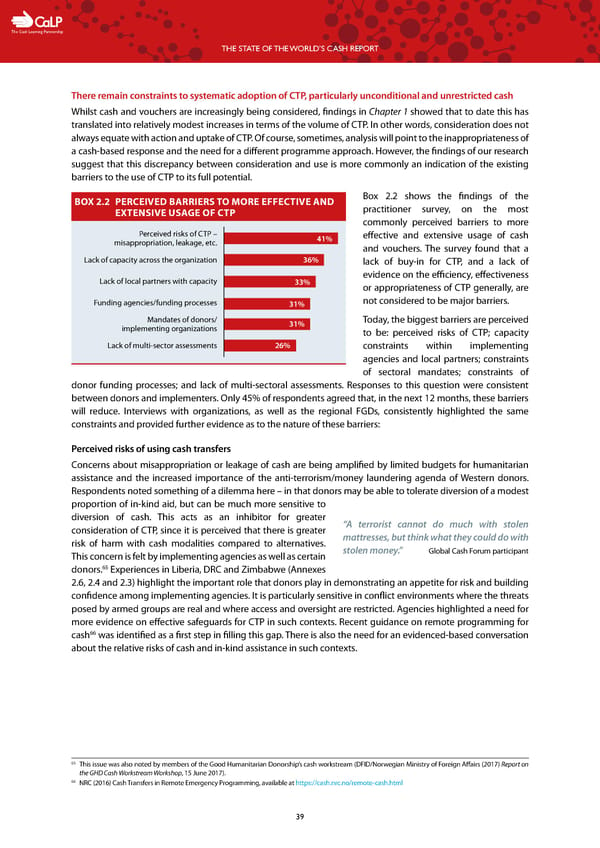C The Cash Learning Partnership THE STATE OF THE WORLD’S CASH REPORT There remain constraints to systematic adoption of CTP, particularly unconditional and unrestricted cash Whilst cash and vouchers are increasingly being considered, findings in Chapter 1 showed that to date this has translated into relatively modest increases in terms of the volume of CTP. In other words, consideration does not always equate with action and uptake of CTP. Of course, sometimes, analysis will point to the inappropriateness of a cash-based response and the need for a different programme approach. However, the findings of our research suggest that this discrepancy between consideration and use is more commonly an indication of the existing barriers to the use of CTP to its full potential. BOX 2.2 PER CEIVED BARRIERS TO MORE EFFECTIVE AND Box 2.2 shows the findings of the EXTENSIVE USAGE OF CTP practitioner survey, on the most commonly perceived barriers to more Perceived risks of CTP – 41% effective and extensive usage of cash misappropriation, leakage, etc. and vouchers. The survey found that a Lack of capacity across the organization 36% lack of buy-in for CTP, and a lack of Lack of local partners with capacity 33% evidence on the efficiency, effectiveness or appropriateness of CTP generally, are Funding agencies/funding processes 31% not considered to be major barriers. Mandates of donors/ 31% Today, the biggest barriers are perceived implementing organizations to be: perceived risks of CTP; capacity Lack of multi-sector assessments 26% constraints within implementing agencies and local partners; constraints of sectoral mandates; constraints of donor funding processes; and lack of multi-sectoral assessments. Responses to this question were consistent between donors and implementers. Only 45% of respondents agreed that, in the next 12 months, these barriers will reduce. Interviews with organizations, as well as the regional FGDs, consistently highlighted the same constraints and provided further evidence as to the nature of these barriers: Perceived risks of using cash transfers Concerns about misappropriation or leakage of cash are being amplified by limited budgets for humanitarian assistance and the increased importance of the anti-terrorism/money laundering agenda of Western donors. Respondents noted something of a dilemma here – in that donors may be able to tolerate diversion of a modest proportion of in-kind aid, but can be much more sensitive to diversion of cash. This acts as an inhibitor for greater “A terrorist cannot do much with stolen consideration of CTP, since it is perceived that there is greater mattresses, but think what they could do with risk of harm with cash modalities compared to alternatives. stolen money.” Global Cash Forum participant This concern is felt by implementing agencies as well as certain 65 donors. Experiences in Liberia, DRC and Zimbabwe (Annexes 2.6, 2.4 and 2.3) highlight the important role that donors play in demonstrating an appetite for risk and building confidence among implementing agencies. It is particularly sensitive in conflict environments where the threats posed by armed groups are real and where access and oversight are restricted. Agencies highlighted a need for more evidence on effective safeguards for CTP in such contexts. Recent guidance on remote programming for 66 cash was identified as a first step in filling this gap. There is also the need for an evidenced-based conversation about the relative risks of cash and in-kind assistance in such contexts. 65 This issue was also noted by members of the Good Humanitarian Donorship’s cash workstream (DFID/Norwegian Ministry of Foreign Affairs (2017) Report on the GHD Cash Workstream Workshop, 15 June 2017). 66 NRC (2016) Cash Transfers in Remote Emergency Programming, available at https://cash.nrc.no/remote-cash.html 39
 The State of the World's Cash | Full Report Page 40 Page 42
The State of the World's Cash | Full Report Page 40 Page 42